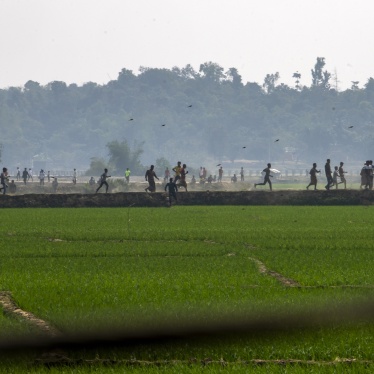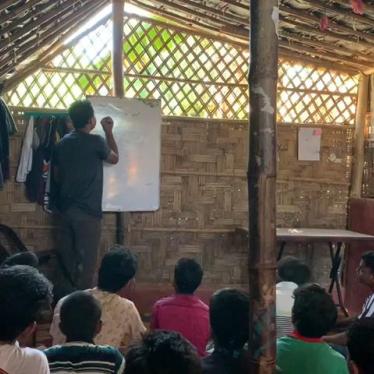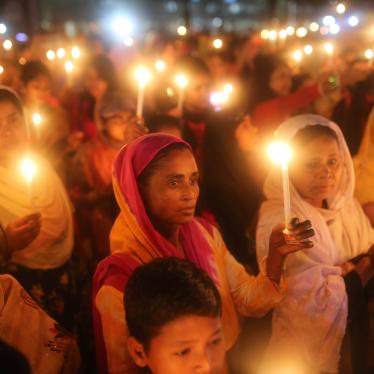This submission addresses the Ending Indefinite and Arbitrary Immigration Detention Bill 2021 (‘the bill’), which establishes a new legal framework governing immigration detention in Australia.[1] The bill makes mandatory detention illegal, provides alternatives to immigration detention that are focused on the immediate needs of refugees and non-citizens, and dismantles Australia’s current offshore immigration detention policies.[2]
Human Rights Watch supports many measures in the bill, which if enacted, would help bring Australia in line with its international law obligations and best practice in relation to immigration detention. These include the following issues:
Ending offshore detention
The proposed law would dismantle Australia’s abusive offshore processing policy.[3] The offshore processing policy has caused immeasurable suffering for thousands of vulnerable asylum seekers for nearly a decade. Since July 2013, the Australian government has forcibly transferred more than 3,000 asylum seekers to offshore processing camps in Papua New Guinea and Nauru.[4] Human Rights Watch has documented the severe abuse, inhumane treatment, and medical neglect suffered by refugees and asylum seekers in Australia’s offshore processing system. The policy is linked to the deaths of 12 people,[5] including from murder,[6] medical neglect,[7] and suicide.[8] Offshore processing is not only harmful, it is extraordinarily expensive, regularly costing the Australian government more than AU$1 billion a year.[9]
Successive Australian governments have used detention of refugees and asylum seekers as a form of deterrence. Under international law, immigration detention should not be used as punishment, but rather should be an exceptional measure of last resort to carry out a legitimate aim.[10] Adults should be detained for the shortest time necessary, while children should not be placed in immigration detention at all.[11]
Children in detention
The bill allows children to be detained as a measure of last resort, placing a seven-day maximum on detention of persons age 18 years or under.[12] As research from Canada has shown, even brief periods of immigration detention are acutely stressful – and in some cases traumatic – for children.[13] International standards recognize that immigration detention of children, alone or with their families, is never in their best interests and is a violation of children’s rights.[14] Authorities should instead “adopt solutions… that allow children to remain with their family members and/or guardians in non-custodial, community-based contexts while their immigration status is being resolved and the children’s best interests are assessed.”[15]
Time limits on immigration detention
The bill sets a limit of three months as the maximum time a person can be held in immigration detention.[16] A person may only be taken into, or kept in, immigration detention for the range of reasons outlined in the bill, which include “to document the non-citizen’s entry” and “to prevent the non-citizen from absconding if there is evidence of a risk of the non-citizen absconding,” among others.[17] We would caution that a risk of absconding should be assessed on an individualized basis using objective criteria.
As of September 2021, the average period for people held in Australian detention was 689 days – the highest average ever recorded.[18] Australian authorities have detained 117 people for five years or more,[19] with several having spent more than 10 years in detention. The protracted and indefinite nature of immigration detention is inhumane[20] and takes a significant toll on detainees. Many refugees and asylum seekers experience significant psychological distress in detention,[21] some have fled traumatic experiences that are then exacerbated by prolonged, indefinite detention in Australia’s onshore and offshore centers.
Provision of information to detainees
Consistent with international law,[22] the bill requires that authorities taking a person into immigration detention provide that person with information, orally and in writing, and in a language the person understands, about their legal rights and the reasons for detention.[23]
Independent monitoring
The bill provides that detention centers be subject to external independent inspections every six months.[24] This is necessary to ensure that detention facilities comply with international human rights standards that require scrutiny and monitoring by an independent body.[25]
Ending mandatory immigration detention
The law, if enacted, would end mandatory immigration detention in Australia. There are currently 1,459 people in immigration detention facilities in Australia.[26] These include some refugees who were transferred to Australia from Nauru or Papua New Guinea for medical treatment who are detained in hotel rooms, where access to sunlight, space to exercise, and fresh air is limited.
Australia’s immigration detention policies violate its obligations under international law,[27] including the prohibition on arbitrary detention under the ICCPR.[28] The UN Working Group on Arbitrary Detention has called for immigration detention to be gradually abolished.[29] The Global Compact for Safe, Orderly and Regular Migration has also called on countries to prevent arbitrary arrest and detention and to “prioritize non-custodial alternatives to detention.”[30] Detention is a severe intrusion on the right to liberty and, in the vast majority of cases, detention for immigration-related reasons is neither necessary nor proportionate to the goal of enforcing immigration laws, particularly in light of the effectiveness of alternatives to detention. Detention of individuals solely due to their immigration status is harmful, expensive, and ineffective as a deterrent to migration.[31]
The framework proposed in the bill draws on United Nation High Commissioner for Refugees detention guidelines,[32] incorporates principles of family unity, the rights and best interests of the child, recognises the lawfulness of seeking asylum, and adheres to refugee and international human rights law.[33] Adopting the proposed framework would help bring Australia in line with international law and best practice and put an end to the immeasurable harm the current regime continues to cause.
Alternatives to detention and access to services
Human Rights Watch has conducted research into pilot programs testing alternatives to immigration detention in several countries, including the United States.[34] Our research has shown that alternatives that place the basic needs and dignity of refugees and non-citizens’ at the forefront of policy, such as those outlined in this bill, offer a rights-respecting alternative to detention while simultaneously furthering governments’ legitimate immigration enforcement aims. Alternatives have proven not only more humane than detention, but effective in achieving immigration enforcement goals at a lower cost than detention.[35]
Community based alternatives to detention have been successfully used in countries across Europe. For example, Bulgaria, Cyprus, and Poland initiated alternative programs in 2017 in which refugees and non-citizens’ are provided with casework support in the community while their cases are progressing. The programs’ services range from legal help to intensive, holistic support. An evaluation after the first two years found that 86 percent of participants across the three programs remained engaged with immigration procedures.[36]
This bill, if enacted, will give priority to refugees and non-citizens’ immediate needs and ensure access to assistance, such as accommodation and financial support, while in the community. It will futher protect their rights by ensuring that any person living in the community has access to services including health services, free and independent legal services, and education.[37]
---
[1] Ending Indefinite and Arbitrary Immigration Detention Bill 2021, Explanatory Memorandum (2021).
[2] Ibid.
[3] Ending Indefinite and Arbitrary Immigration Detention Bill 2021, section 11.
[4] “Australia: 8 Years of Abusive Offshore Asylum Processing,” Human Rights Watch news release, July 15, 2021, https://www.hrw.org/news/2021/07/15/australia-8-years-abusive-offshore-asylum-processing.
[5] Ben Doherty, Nick Evershed and Andy Ball, “Deaths in offshore detention: the faces of the people who have died in Australia's care,” The Guardian, June 20, 2018, https://www.theguardian.com/australia-news/ng-interactive/2018/jun/20/deaths-in-offshore-detention-the-faces-of-the-people-who-have-died-in-australias-care (accessed January 14, 2022).
[6] Eric Tlozek, “Reza Barati death: Two men jailed over 2014 murder of asylum seeker at Manus Island detention centre,” ABC News, April 19, 2016, https://www.abc.net.au/news/2016-04-20/manus-island-detainees-angry-reza-barati-murder-sentences/7340182 (accessed January 14, 2022).
[7] Josh Robertson, “Asylum seeker Hamid Khazaei's death from leg infection was preventable, Queensland coroner finds,” ABC News, July 30, 2018, https://www.abc.net.au/news/2018-07-30/asylum-seeker-hamid-khazaei-coronial-inquest-death-preventable/10050512 (accessed January 14, 2022).
[8] Max Walden, “Asylum seekers in detention 200 times more likely to commit self-harm than Australians, research finds,” ABC News, October 14, 2019, https://www.abc.net.au/news/2019-10-14/asylum-seekers-in-detention-200-more-likely-to-commit-self-harm/11600148 (accessed January 14, 2022).
[9] Refugee Council of Australia, “Offshore processing statistics,” January 8, 2022, https://www.refugeecouncil.org.au/operation-sovereign-borders-offshore-detention-statistics/6/ (accessed January 21 2022).
[10] International Covenant on Civil and Political Rights (ICCPR), G.A. res. 2200A (XXI), 21 U.N. GAOR Supp. (No. 16) at 52, U.N. Doc. A/6316 (1966), 999 U.N.T.S. 171, entered into force March 23, 1976, article 9(1) (“Everyone has the right to liberty and security of person. No one shall be subjected to arbitrary arrest or detention. No one shall be deprived of his liberty except on such grounds and in accordance with such procedure as are established by law.”) Australian became a party to the ICCPR in 1980.
[11] Sophie McNeill (Human Rights Watch), “Djokovic Case Highlights Australia’s Cruel Immigration Policies,” dispatch, January 10, 2022, https://www.hrw.org/news/2022/01/10/djokovic-case-highlights-australias-cruel-immigration-policies.
[12] Ending Indefinite and Arbitrary Immigration Detention Bill 2021, section 21.
[13] Rachel Kronick, Cécile Rousseau, and Janet Cleveland, “Asylum-Seeking Children’s Experiences of Detention in Canada: A Qualitative Study,” American Journal of Orthopsychiatry, vol. 85 (2015), pp. 287-294.
[14] UN Committee on Migrant Workers and UN Committee on the Rights of the Child, Joint General Comment No. 4 (Committee on Migrant Workers) and No. 23 (Committee on the Rights of the Child) on State Obligations Regarding the Human Rights of Children in the Context of International Migration in Countries of Origin, Transit, Destination and Return, U.N. Doc. CMW/C/GC/4-CRC/C/GC/23 (November 16, 2017), para. 5; UN Working Group on Arbitrary Detention, Revised Deliberation No. 5 on Deprivation of Liberty of Migrants, U.N. Doc. A/HRC/39/45, annex (July 2, 2018), paras. 11, 40; UN Human Rights Council, Report of the Special Rapporteur on Torture and Other Cruel, Inhuman or Degrading Treatment or Punishment, U.N. Doc. A/HRC/28/68 (March 5, 2015), para. 80. See also Joint General Comment No. 4 (Committee on Migrant Workers) and No. 23 (Committee on the Rights of the Child), paras. 6-13; Letter to Theo Francken, Secretary of State for Migration and Asylum, Belgium, from Nils Mužnieks, Commissioner for Human Rights, Council of Europe, December 2, 2016, https://rm.coe.int/ref/CommDH(2016)43 (accessed January 21, 2022).
[15] Joint General Comment No. 4 (Committee on Migrant Workers) and No. 23 (Committee on the Rights of the Child), para. 11.
[16] Ending Indefinite and Arbitrary Immigration Detention Bill 2021, section 12.
[17] Ibid., section 16.
[18] Australian government, Department of Home Affairs, “Immigration Detention and Community Statistics Summary,” September 30, 2022, https://www.homeaffairs.gov.au/research-and-stats/files/immigration-detention-statistics-30-september-2021.pdf (accessed January 21, 2022).
[19] Ibid.
[20] Human Rights Watch, Dismantling Detention International Alternatives to Detaining Immigrants, (New York: Human Rights Watch, 2021), https://www.hrw.org/report/2021/11/03/dismantling-detention/international-alternatives-detaining-immigrants.
[21] Kyli Hedrick, Gregory Armstrong, Guy Coffey, and Rohan Borschmann, “Self-harm Among Asylum Seekers in Australian Onshore Immigration Detention: How Incidence Rates Vary by Held Detention Type,” BMC Public Health, vol. 20 (April 30, 2020) https://bmcpublichealth.biomedcentral.com/articles/10.1186/s12889-020-08717-2 (accessed January 21, 2022).
[22] International Covenant on Civil and Political Rights (ICCPR), G.A. res. 2200A (XXI), 21 U.N. GAOR Supp. (No. 16) at 52, U.N. Doc. A/6316 (1966), 999 U.N.T.S. 171, entered into force March 23, 1976, article 9(2).
[23] Ending Indefinite and Arbitrary Immigration Detention Bill 2021, section 18.
[24] Ibid., section 22.
[25] UN General Assembly, United Nations Standard Minimum Rules for the Treatment of Prisoners (the Nelson Mandela Rules), adopted by the General Assembly, 8 January 2016, A/RES/70/175, rules 83-85.
[26] Department of Home Affairs, “Immigration Detention and Community Statistics Summary.”
[27] Refugee Council of Australia, “Australia’s detention policies,” May 20, 2020, https://www.refugeecouncil.org.au/detention-policies/ (accessed January 21, 2022).
[28] See, for example, Australian Human Rights Commission, “Hamedani v Commonwealth of Australia (Department of Home Affairs) (2020)” September 15, 2020, https://humanrights.gov.au/our-work/asylum-seekers-and-refugees/publications/hamedani-v-commonwealth-australia-department-home (accessed January 14, 2022); Australian Human Rights Commission, “Mr AP v Commonwealth of Australia (Department of Home Affairs) (2020)” August 24, 2020, https://humanrights.gov.au/our-work/asylum-seekers-and-refugees/publications/mr-ap-v-commonwealth-australia-department-home (accessed January 14, 2022).
[29] Human Rights Council, Report of the Working Group on Arbitrary Detention, “Promotion and Protection of All Human Rights, Civil, Political, Economic, Social and Cultural Rights, Including the Right to Development,” U.N. Doc. A/HRC/13/30, January 15, 2010 https://www2.ohchr.org/english/bodies/hrcouncil/docs/13session/A.HRC.13.30_AEV.pdf (accessed January 14, 2022), paras. 58-59.
[30] Global Compact on Safe, Orderly and Regular Migration, (A/RES/73/195), UN General Assembly, January 11, 2019. https://undocs.org/A/RES/73/195 (accessed January 14, 2022).
[31] Human Rights Watch, Dismantling Detention International Alternatives to Detaining Immigrants, (New York: Human Rights Watch, 2021), https://www.hrw.org/report/2021/11/03/dismantling-detention/international-alternatives-detaining-immigrants.
[32] UN High Commissioner for Refugees (UNHCR), Guidelines on the Applicable Criteria and Standards Relating to the Detention of Asylum-Seekers and Alternatives to Detention, 2012, https://www.unhcr.org/publications/legal/505b10ee9/unhcr-detention-guidelines.html (accessed January 14, 2022).
[33] Ending Indefinite and Arbitrary Immigration Detention Bill 2021, Explanatory Memorandum (2021).
[34] Human Rights Watch, Dismantling Detention International Alternatives to Detaining Immigrants.
[35] Ibid.
[36] Human Rights Watch, Dismantling Detention International Alternatives to Detaining Immigrants.
[37] Ending Indefinite and Arbitrary Immigration Detention Bill 2021, section 13.







